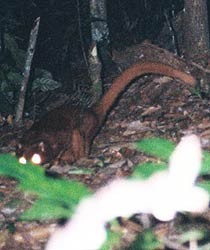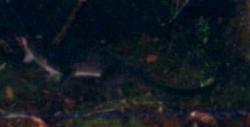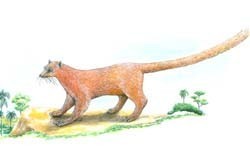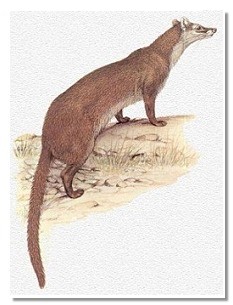Borneo’s New Mammal
Posted by: Loren Coleman on October 12th, 2006
On December 5 and 7, 2005, Cryptomundo scooped the mainstream media with some analytical insights of the following Borneo photographs and the probable identification of the animal in the photographs. As this has surfaced again with regard to "new mammals" discoveries, and there are so many new Cryptomundo readers, here are those first postings on this mystery animal find.
What do you think this looks like? There is exciting news out of Borneo. A new red-furred animal larger than a domestic cat has reportedly been discovered on this remote island of Indonesia.

On December 5, 2005, the World Wide Fund for Nature (WWF) announced that they have discovered the "first new carnivore to be found in the region since the Tonkin otter-civet emerged in Vietnam in 1930." Also, the WWF said it would be the first new mammal to be specifically found on the island of Borneo since the Borneo ferret-badger in 1895.
The new carnivore was found in Kayan Mentarang National Park in Kalimantan, the Indonesian part of Borneo.
According to reports in The Times of London and other sources the "only evidence that exists are photographs taken by an automatically triggered camera on a jungle trail in Indonesia in 2003. Infuriatingly, a large leaf obscured the creature’s face as the shutter went off."
Stephen Wulffraat, discoverer of the so-far unnamed animal, noted: “We showed the photos to locals who know the wildlife of the area, but nobody had ever seen this creature before. We also consulted several Bornean wildlife experts. Some thought it looked like a lemur, but most were convinced it was a new species of carnivore.”
But doesn’t it seem obvious this looks more like a civet, than a primate?
The photographs show, writes reporters Nick Meo and Nigel Hawkes, "an enigmatic, red-furred creature with tiny ears and distinctive markings. The leaf that obscures its face makes it impossible to say if it has a pointed snout like a dog or fox, or a flat face like a cat. A second photo, from behind, shows it to have a long, bushy tail rather like a fox, and large hind legs. It is slightly larger than a domestic cat."
The mystery animal’s pictures were initially taken by WWF field researchers in 2003, but the photos were kept unpublished by the WWF as research continued. The WWF decided to make public the photos with the release of a book about Borneo.
The animal is slightly larger than a domestic cat with dark red fur and a long bushy tail. It was photographed twice by a night camera trap.
The photograph here is copyrighted by the WWF, and reproduced here for research purposes.
Possible Identification Proposed: The Rediscovery of an Extinct Species
The new animal from Borneo does somewhat match another camera trap "mystery creature" photographed by Malaysian wildlife specialists, and pictured directly below. This gave me a hint of what the "new" animal might be. Take a peek…


Photo credit goes to the Wildlife Conservation Society, Upper Baram Project, Malaysia. This organization obtained an interesting series of camera trap photos in 2004 on the unlogged areas of Mount Murud Kecil, Sarawak. One is of this slender unknown civet, shown above, with a very long tail, pale underparts and white around the muzzle, similar to Hose’s palm civet. This individual was photographed on the ridge of the mountain, far from the streams which are the Hose’s palm civet’s supposed habitat.

Compare the photos from Mount Murud Kecil, at the top of this blog, with this drawing of the newly discovered Borneo "civet." I think there is a good case to be made that the new Borneo animal is the allegedly extinct (since 1955) Hose’s palm civet, and may be similar to the above photographed "underreported" unknown civet from Mount Murud Kecil.
The new mammal "discovered" in Borneo, naturally, comes to the attention of cryptozoology and an analysis based on a broad review of what is ethnoknown about similar cryptids is helpful in revealing the "new" Borneo animal’s identity.
Please recall, this new Borneo animal is known only from two camera trap photographs (see our earlier blog), one of which shows this new animal with a leaf across its face and the other from behind. As far as is known, that is what has been deemed as evidence of this new animal’s "discovery."
But it does seem more proper to say this is the probable "rediscovery" of an extinct form, the Hose’s palm civet, as can be seen in a drawing from the excellent Lioncrusher reference site and shown directly below this paragraph. The Hose’s palm civet appears to be what we are talking about from Borneo, and in all of these situations.

Also, the "new" Borneo animal and the unknown Mount Murud Kecil civet reinforce, positively, the use of camera traps, as a method to show "hidden" animals, the foundation subjects of cryptozoology, literally the study of hidden animals.
With regard to this specific "new" Borneo animal, as noted above, it does therefore match this other camera trap "mystery creature" photographed by Malaysian wildlife specialists, which has never been widely shown before. The "new" Borneo animal is therefore a civet, members of the family Viverridae, and, I speculate, an example of a rediscovered (no longer extinct) Hose’s Palm Civet (Diplogale hosei).
BTW, the viverrids such as these Borneo civets, and the American procyonids (coatmundis and kinkajous) look like each other because of convergent evolution.
Thanks to Cameron and Matt Bille for data that reinforced our initial identification speculations in these "civet" blogs.
About Loren Coleman
Loren Coleman is one of the world’s leading cryptozoologists, some say “the” leading living cryptozoologist. Certainly, he is acknowledged as the current living American researcher and writer who has most popularized cryptozoology in the late 20th and early 21st centuries.
Starting his fieldwork and investigations in 1960, after traveling and trekking extensively in pursuit of cryptozoological mysteries, Coleman began writing to share his experiences in 1969. An honorary member of Ivan T. Sanderson’s Society for the Investigation of the Unexplained in the 1970s, Coleman has been bestowed with similar honorary memberships of the North Idaho College Cryptozoology Club in 1983, and in subsequent years, that of the British Columbia Scientific Cryptozoology Club, CryptoSafari International, and other international organizations. He was also a Life Member and Benefactor of the International Society of Cryptozoology (now-defunct).
Loren Coleman’s daily blog, as a member of the Cryptomundo Team, served as an ongoing avenue of communication for the ever-growing body of cryptozoo news from 2005 through 2013. He returned as an infrequent contributor beginning Halloween week of 2015.
Coleman is the founder in 2003, and current director of the International Cryptozoology Museum in Portland, Maine.










Has anyone else noticed that no one ever assumes hoax in these incidents? Yet, when someone brings in a photograph of Sasquatch, Champ, or a Thylacine, the first reaction is, “It’s a hoax!” Where’s the objectivity? You can claim that there is nothing to gain by faking a smaller mammalian, but this simply isn’t true. You are much more likely to get a research grant to look for say, an unknown civet, than you are for Bigfoot. Granted, photo’s of Sasquatch will get you much more media attention, but no agency or university is going to shell out hundreds of thousands of dollars for scientific research into your “discovery” and unfortunately that’s what is needed, sometimes to find even well known but rare animals.
The sorry state of science in the 21st century is the reason I make my assesment. I don’t think it is, but somebody has to say it, “it’s a hoax!”
you gotta wonder how they find a new bird or mouse but they cant find a 10ft tall 800lb animal(BF)
MrInspector – there are other considerations here. I have never seen an alleged photo of a thylacine which was produced by a camera trap.
At least for me, personally, I feel I don’t automatically assume every photo of an unlikely creature (thylacine, bigfoot) is a hoax. In my recent thylacine analysis I acknowledge my initial intuition that it’s a hoax, but still go on to analyse it in detail to see what I can find.
Back to the civet – the theory sounds sound. I’m very unfamiliar with Indonesian fauna, but from what I read here the theory makes a lot of sense.
1955 to 2005 – just barely clipped the “Extinct” requirements when these photos turned up! 🙂
Interestingly though – do the photos constitute “proof” of the civet still existing? I think not.
In line with some thylacine sighting reports, most of us who’ve seen the evidence can say “we know it’s still there”, yet on paper, we don’t have proof.
Again, only a trapping program (which must generally be government authorised) can establish with proof that this is indeed the civet we think it is.
If Giganto was trying to cross the border, he might be caught.
I find it somewhat odd that the locals can not ID the animal. Also that the photos were held from the public for so long. I would like to know if the photos were taken with a film or digital camera. If with a film camera I would like to inspect the actual negative. I was in the photo lab business for some 25+ years, and upon inspection of negative, could make a determination if photo is real or touched-up. But for now and until they bring in an actual corpse, I say “FAKE”!
Borneo is a hot bed of Biodiversity.
I would say the photgraphed animal is a Civet. Don`t tell the Chinese, they are liable to eat it.
I agree everytime a new mammal is found presto great video man but we seem never to see a great photo of champ or bigfoot even by the way of video the taping is always to far away or its distorted but i hope sooner or later we finally see a clear video of bigfoot but i think the yeti is more realer than bigfoot.
I’m not convinced that the “new carnivore” is a viverrid, although it greatly resembles a fossa, from what is visible in the photo. Too bad the muzzle is obscured. It also greatly resembles an extremely rare cat known as the Bornean Bay Cat. That cat is so rare that the first photograph of a living specimen was made as late as 1998. It was thought to possibly be extinct. The brilliant rust color, long, slender body, and extra-long round fluffy tail look like the Bornean Bay Cat’s.
Either way, new species or a new photo of a recently rediscovered rare feline, it sure is welcome news.
Are you sure it’s the same animal in the two pictures? The colors seem a bit off & the one in the first picture seems to have much smaller ears. I can see how this could be two, closely related, species.
As for why people are more likely to scream “hoax” when seeing pictures of sasquatch, etc. I have never seen, besides the Patterson film, any sasquatch photograph which could compare to these, when it comes to so clearly showing a living creature.
I can’t put my finger on it, but I think I’ve seen something like this one before. I agree with the last 2 bloggers–I love how an 8 to 10 foot primate is always blurry or out of focus, but a feline/weasel type comes in almost perfect. This one looks familiar, therefore probably not a new creature. I know so little about what lives there, that if I’ve seen it, then it’s probably no more than something living in he area. As for the natives not knowing, there is a lot of that area the natives don’t go through without reason. They believe in actual haunts in the forest and/or there’s possible tribal conflict over who actually has right to the forest, therefore no one will enter it without a good reason.
Aye, Lads! It’s a Civet if I’ve ever seen one.
The Bay Cat suggestion is interesting. (For one thing, I didn’t know about this cat). Having found photos online, I think the tail of our mystery animal is not as fluffy – but that’s in comparing one adult male Bay cat to our slightly-larger-than-a-domestic-cat cryptid.
However – it got me thinking further – how about eye-shine? Surely someone has thought about this? (Perhaps it was mentioned in the earlier thread?) Eye-shine is often a diagnostic feature of animals.
I did find a striped civet photo showing eye-shine of nearly identical colour.
Searching for Hose’s Palm Civet online, yields at least two actual photos (one of which shows the same eyeshine colour). My question is – if this is supposed to be extinct, then how come at least two people are publishing modern-day photos of it? The second photo of Hose’s Palm Civet is only available in Google’s cache, however, and seems to be from the same series depicted here.
Even travel guides indicate likely locations for rare sightings of Hose’s civet.
Lastly, I don’t think the mystery animal is a Hose’s Palm civet. Compare the two eye-shine photos in this article. Note the distance between the eyes in proportion to the distance between the ears. Our mystery animal has more widely spaced eyes (relative to the ears) than Hose’s palm civet.
The mystery animal may be a new civet.
The Bay Cat on this page also has eyes more closely set together than the mystery animal – although its colouration also does not match the mystery cryptid, nor other photos of Bay cats.
Fluffy tails and colouration might be accounted for by differences in individuals, but distance between eyes and ears I would expect to be consistent for mammals such as cats and civets.
I don’t think this one matches either of those suggestions, but may be a new civet.
youcantryreachingme,
If you check out the excellent reference book Wild Cats of the World by Mel & Fiona Sunquist, there is an outstanding article on the Bornean Bay Cat that has pictures much more like this mystery animal than the pictures that come up in, say, a Google search, including the first photo ever taken of one. It was a female that had been held captive by villagers, up to the point of near death, and although she was extremely emaciated and died soon after, she seems to be more representative of the species than some pictures I have seen. In fact, some of the pictures of “Bay Cats” are actually photos of Asian Golden Cats, which are related to the Bay Cat.
Here is a link to an excerpt from the book on Amazon.com.
The photo is also reproduced in color in one of the color plates sections of the book.
I strongly recommend this book to anyone who has an interest in cats. Much of the material covered is not readily available anywhere else, and it is fascinating.
I think the mystery animal might be a Bornean Bay Cat. But the more I look at it, the more I think “fossa”.
Here is a link to the WWF’s page with the first photo above, plus another clear photo of the same animal from behind.
Fossas are considered by most to be viverrids, but until fairly recently they were thought to be a primitive member of the cat family. Certainly they must bear a very close resemblance to the animals that were the common ancestors of cats & viverrids.
Here is a link to a page which shows fossas and other rare wildlife of Madagascar, which, like Borneo, is a huge island with unique fauna.
So I think that it probably IS a creature entirely new to science, maybe a cat, maybe a viverrid. Since fossas are native only to Madagascar, I would not think it is of the same species as the fossa from Madagascar, Cryptoprocta ferox (gotta love that name, dontcha?). But I think it may be another viverrid of ancient lineage very like the fossa.
BTW, all cats and all viverrids have eyeshine. Cats and viverrids such as genets are very closely related among the families of carnivores, and share many of the same traits. For instance, genets and some other viverrids even have a type of tabby coloring that is found in cats, and many also have retractible claws. Oh, and some species purr like cats too.
As a matter of fact, small genets have been kept as mousers for centuries in regions where they are native. Even the ancient Romans often kept genets as pets.
kittenz – what excellent cat information! Thank you 🙂
crypto_randz:
MORE REALER!?! I can get the occasional spelling error, b/c these keyboards are not the least sensitive in the world, but COME ON!! Proposing unlikely theories is understandable, b/c it’s human instinct, but you’ve got to watch for errors like THAT!
P.S. Reality cannot be gauged in amounts, but rather guessed at using probability.
kittenz:
Ooh, sweet! That’s the same species name as the Jurassic pliosaur, Liopleurodon ferox!
BTW, I just heard of a predatory stick-insect that was recently discovered in South Africa. 12 specimens were taken for study in Britain, but 2 were, umm, “lost” during the trip. A few others were dissected, and the missing 2 were, uhh “found.”
Crypto – where does the stick insect come into it?
If we’re taking a diversion, I hope to collect a new species of Australian cicada – one that would dwarf our current largest. I’ll keep you posted, but you’ll have to wait some months 🙂